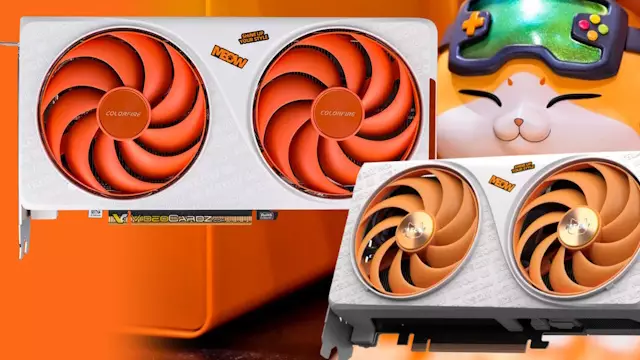In an industry saturated with predictable designs and incremental upgrades, Colorful—a Chinese graphics card manufacturer—has once again dared to break the mold with its latest releases: the flamboyant Colorfire Meow RTX 5050 GPUs. While these GPUs immediately catch the eye with their vivid orange fans and whimsical cat-themed chassis, they also introduce a perplexing twist to Nvidia’s expanding RTX 50 series lineup. The bright aesthetic may be a breath of fresh air, but the value proposition of these cards demands a more critical look.
An Unorthodox Branding Strategy
Colorful’s decision to house the RTX 5050 under two vastly different sub-brands—the experimental Meow series and the more mainstream iGame Ultra lineup—raises eyebrows. The iGame Ultra RTX 5050, dressed in a stark white shell livened by graffiti-style pink accents, echoes previous iGame designs and is offered in both dual- and triple-fan variants. Conversely, the Meow series breaks all conventions with cat head embossments, dual large orange fans, and an intentionally playful design ethos.
On the surface, this split branding might reflect Colorful’s attempt to differentiate a budget-friendly, somewhat niche product (the Meow) from their established premium brand (the iGame Ultra). However, this strategy also smacks of market confusion. Why release the same GPU chip under two seemingly unrelated lines? The fragmented approach dilutes brand identity and leaves consumers questioning the true positioning and capability of the RTX 5050.
When Specs Don’t Fully Impress
Delving into the hardware, the Nvidia RTX 5050 situates itself awkwardly in the product ecosystem. Essentially an entry-level card by current standards, the 5050’s performance reportedly lags slightly behind the earlier RTX 4060, a card already regarded as on the lower end of the playing field for demanding gaming and creative workloads. This demotion in raw specs is perplexing given Nvidia’s continued push to position the RTX 50 lineup as a next-generation leap forward.
Where the RTX 5050 might redeem itself—albeit partially—is through Nvidia’s DLSS 4 technology, a cutting-edge AI-powered upscaling solution designed to enhance frame rates and overall visual fidelity. DLSS 4’s multi-frame generation promises to breathe life into weaker hardware by generating synthetic frames and smoothing gameplay. Yet, relying on software tricks to mask hardware shortcomings is a risky bet. It risks dissatisfaction among gaming enthusiasts who prize onto-ground performance over marketing gimmicks.
The Appeal and Pitfalls of Quirky Design
Colorful’s Meow series is laudable for injecting personality into a segment of PC hardware often accused of blandness. The dual orange fans and cat motifs offer more than mere aesthetic novelty—they hint at a youthful brand willing to experiment with form and function. Furthermore, Colorful claims these cards are optimized to perform better when paired together, potentially offering a unique cooling solution for budget-conscious builders seeking style and substance.
Yet, aesthetics alone do not secure success in the fiercely competitive GPU market. Transparency about real-world performance, thermal management, driver support, and long-term reliability must match the flamboyant appearance. There’s also a tacit worry that these cards, being budget-tier, might struggle with stability or require awkward workarounds, such as physical reinforcement on motherboards, which some entry-level GPUs have previously necessitated.
Market Implications and Consumer Perception
The RTX 5050’s unexpected debut, ahead of anticipated July timelines, feels rushed—an impression fueled by its middling specs and inconsistent branding. This suggests Nvidia might be hedging bets with a low-cost option intended to democratize DLSS 4’s AI capabilities, aiming to attract gamers looking to upgrade affordably in a period of economic caution.
However, the risk lies in confusing consumers further. The GPU market is no stranger to “entry-level” cards that frustrate buyers with poor value or early obsolescence. When combined with Colorful’s erratic branding strategy, the RTX 5050 may fail to capture the enthusiasm it needs to survive. Instead, it might become a footnote—an interesting design experiment but ultimately a product that struggles to justify its existence.
For those seeking standout hardware with personality, the Meow series’ bold aesthetics certainly deliver. But for value-conscious buyers focused on raw power and future-proofing, the RTX 5050 may feel like a half-hearted answer at best. As always, only thorough, hands-on reviews will truly determine whether these vibrant and curious GPUs find their niche or fall victim to niche confusion.

